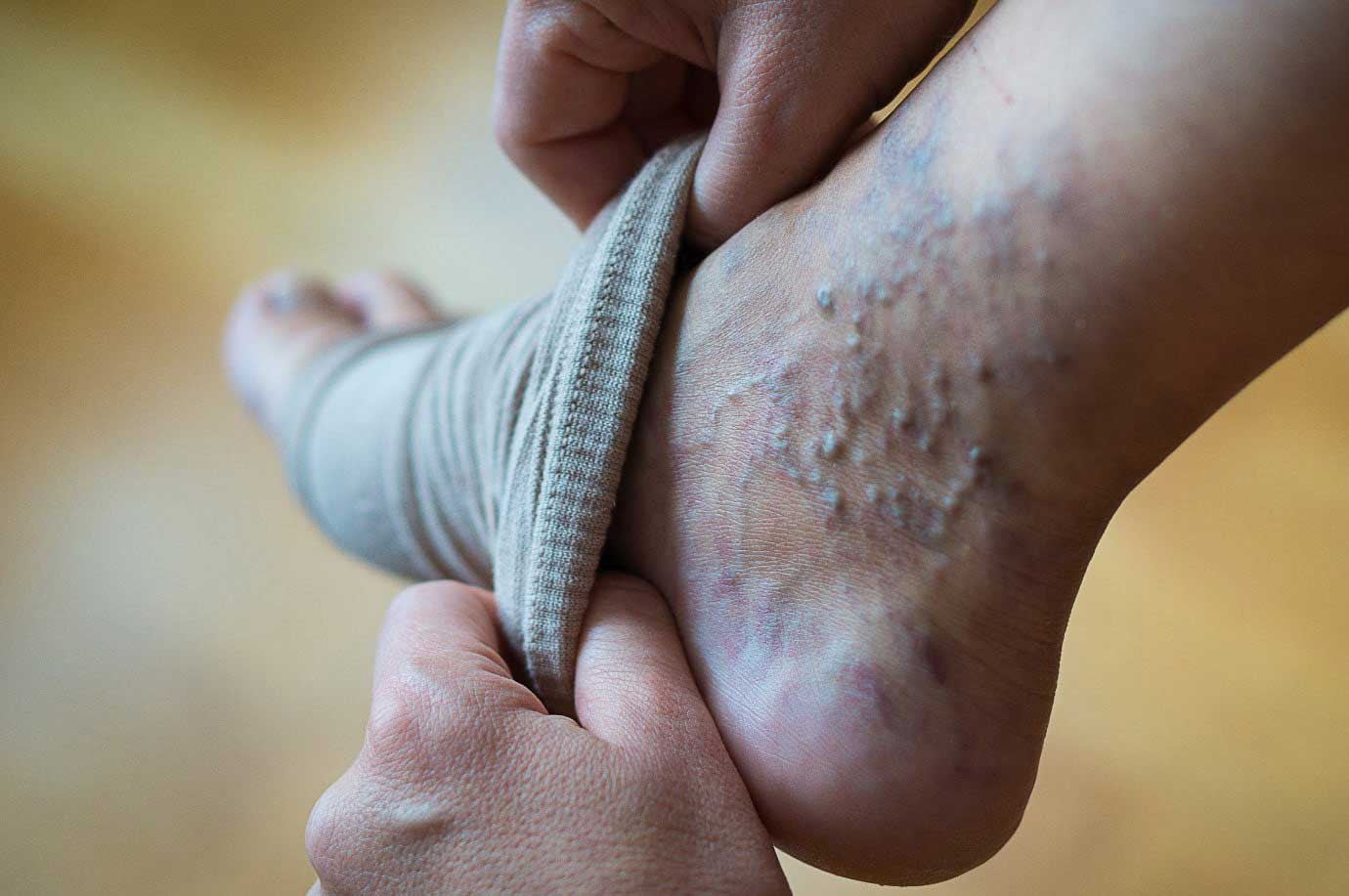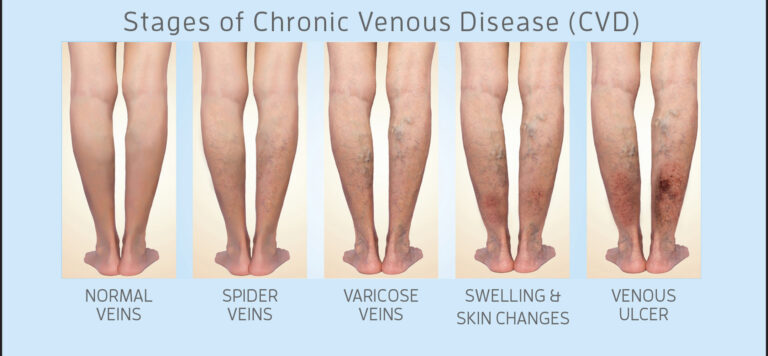FEET VARICOSE VEINS
Varicose veins or Corona Phlebectasia appear around the ankle or foot. Varicose veins or spider veins affect the feet, thigh and calves. Veins in the feet contain valves that lose their function over time. As the valves lose function the blood backs up in the veins, stretching the veins and further leading to varicose veins.
It is a cluster of veins at the ankle and foot creating an appearance of a blue foot. It is a sign of advanced vein disease and often indicates failed valves in the great saphenous vein, one of the several veins that drain the surface of your legs.
Spider veins are deceptively considered as a cosmetic issue. On the contrary, the presence of corona phlebectasia is a clinical sign. It is associated with venous reflux, mostly saphenous vein reflux, but the deep or perforator veins can also be incompetent. The underlying medical condition can be evaluated using duplex ultrasound examination. This is helpful in accurately devising the treatment plan.

WHAT CAUSES CORONA PHLEBECTASIA?
The key function of veins is to transport blood in a single direction to the lungs and heart in order to be oxygenated. The valves in the vein walls keep the blood flowing in one direction do not work causing blood to leak backward known as venous reflux or venous insufficiency. This leads to blood accumulating in a part of the vein resulting in bulge on the surface of the skin.
In case of pressure and valve malfunction in veins you might experience:
- Prominent veins– visibly large and bulging varicose veins appearing smaller spider like veins or reticular veins, without any symptoms or pain.
- Prominent veins along with symptoms such as swelling in the leg, or venous ulcers. It causes breakdown in skin around the lower leg or ankle region.
- Only symptoms with no visible abnormal veins
Some of the underlying medical condition also cause spider veins in foot and ankle including:
- Lymphedema: Varicose veins could affect the lymphatic system that transports and removes the waste products along with toxins from the body. Lymphatic system plays a key role in immune system functioning. Varicose veins can damage the lymphatic system leading to lymphedema, which causes swelling in the feet and toes. People suffering with lymphedema may also develop cellulitis that is a serious skin infection resulting in inflammation to the soft tissue of the skin. This could also cause venous stasis dermatitis causing the skin to become leathery and ruddy-brown. In severe cases clear-yellow fluid weeps through the skin.
- Dermatitis: Varicose veins could also cause dermatitis resulting in an itchy, inflamed rash often appearing on the lower leg or ankle. Dermatitis might cause bleeding, skin ulcers, or sores, which can be painful. In severe cases they can become infected if scratched or irritated.
- Superficial thrombophlebitis: Spider veins can cause inflammation and the formation of a clot in the vein close to the surface of the skin. It causes pain and leads to other problems in the affected area.
There are a number of factors besides inactivity that usually increase the risk of developing varicose veins in your feet and worsening your symptoms such as:
- Obesity: Being overweight would increase the risk of developing spider veins. The valves in these areas fight against gravity for un-interrupted circulation of blood. This puts pressure on your body’s weight on these veins. The excess weight would weaken the valves and they struggle to cope with the increased demand on your circulatory system. This will eventually become even weak trying to support your increased body mass.
- Poor Nutrition: Processed fats, refined sugars or caffeinated beverages affect your immune system along with your digestion. These would reduce the ability to absorb nutrients causing the veins to become weak.
- Pregnancy: During pregnancy the valves in your veins are placed under an increased amount of strain. The extra amounts of blood produced in the body to support the growing fetus puts pressure on inferior vena cava vein causing the veins to become weakened and impaired. In addition, your increased weight puts more stress on your feet, increasing the chance of developing varicose veins.
- Stress: Stress will plunge your nervous system into a state of excitement and stimulate your primordial reflexes. The stress causes your blood to pump more forcefully, placing more strain on your blood vessels. Adrenaline and histamine are released into the body during bouts of stress adding inflammatory pressures on blood vessels.

WHAT ARE SYMPTOMS OF VARICOSE VEINS?
Varicose veins sometimes might cause no symptoms. The large, twisting veins can cause no discomfort, while damaged veins that are less visible can become extremely painful.
Symptoms associated with varicose veins leads to pain and discomfort along with:
- Feeling of heavy and achy legs
- Muscle cramps
- Throbbing and burning feeling in your legs
- Swelling in your calves and around ankles
- Discomfort around affected veins
- Skin discoloration
- Restless leg and cramping
- Heaviness or fatigue in the legs
- Breaks in skin around affected area
- Ankle and foot vein is swollen, red, or tender to touch
Your symptoms worsen during warm weather, late in the day, or when you are standing for extended periods.
Phlebitis could also cause pain, which occurs when varicose veins become inflamed and form blood clots. You can identify phlebitis if you have pain, heat, hardness and discoloration in your feet.
Sometimes the vein bursts resulting in blood to pool around the affected area along with pressure and toxins to accumulate. In moderate to severe cases, ulcers may develop, your skin may tear due to varicose veins, which can be extremely painful.
HOW ARE VARICOSE VEINS TREATED?
Podiatrist would focus on relieving the symptoms associated with varicose veins by:
- Elevating the legs above the level of your heart provides immediate relief from pain and discomfort. This makes blood flow easier in your lower body toward the heart, and the venous valves will function more effectively.
- Stretching exercise would help hydration and physical movement supporting healthy blood circulation.
- Using cold water helps in relieving pain. This helps to alleviate swelling, feeling of heaviness and overall discomfort and leg cramps.
Podiatrist would also recommend various non-invasive techniques for relief in severe cases:
- Endovenous Laser Ablation (EVLA): Under ultrasound guidance, a laser fibre is placed into the affected vein through a tiny incision. The laser is activated in conjunction with removal of fiber producing a reaction in the vein wall resulting in collapse and sclerosis of the vein wall with minimal discomfort.
- Ultrasound Guided Sclerotherapy: This is a highly specialized procedure that requires injecting a sclerosant solution into the abnormal veins. This causes the vein wall to collapse. The veins dissolve and disappear gradually as the body absorbs the solution.
- Radiofrequency Ablation: This relies on heat based damage to the vein causing immediate closure of the vein. The treatment by radiofrequency ablation will gradually undergo complete absorption and disappear gradually.
OUTLOOK
Patients suffering from protruding feet or ankle veins usually have venous insufficiency around the small saphenous veins or the perforator veins in the lower leg. This results due to effects of gravity and pressure increasing on veins in the lower parts of the body. Prevention by modulating the daily activities are necessary instead of the treatment.
If you or anyone you know is suffering from foot problems, our expert providers at Specialty Care Clinics will take care of your health and help you recover.
Call us on (469) 545-9983 to book an appointment with our specialists.
